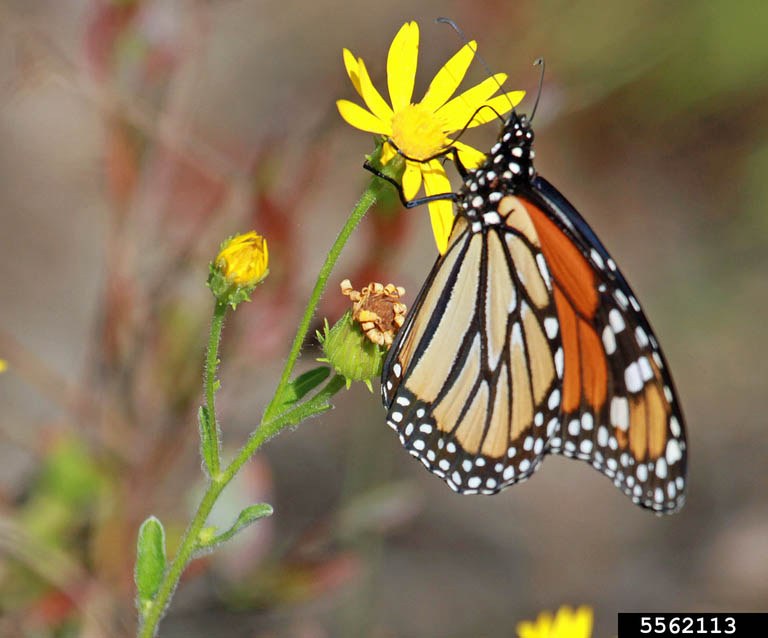The monarch butterfly with its striking orange and black coloration is one of our most widespread and well-known insects.

James R. Holland, Bugwood.org
Monarch (Danaus plexippus)
During the spring, summer and fall Pennsylvania is home to these beautiful creatures. Monarchs however, are unable to tolerate the freezing temperatures experienced in most of North America. This fact triggers their fascinating long-distance migration to Mexico in late summer and fall. Theirs is one of the longest migrations of any insect, with individuals able to fly thousands of miles. Unfortunately, the monarch population has decreased dramatically in recent years. Following are some of the multiple factors contributing to this decline:
- Widespread loss of native habitat
Loss of milkweed (larval host) plants due to:
-- Herbicide use
-- Frequent mowing of large lawns, community spaces and highway roadsides
-- Modern agricultural practices - Lack of nectar plants during migration
- Insecticide application
- Planting and proliferation of non-native and invasive plant species
- Logging of the fir trees in which they roost on their wintering grounds in Mexico
Monarch caterpillars feed on the leaves of milkweed plants.
Monarch butterflies normally arrive in Pennsylvania in May. These individuals will not live to make the fall migration. They are here to produce offspring during the summer who will hopefully survive to migrate to Mexico. After breeding, the females must find milkweed (Asclepias) plants on which to lay their eggs. They fly over the landscape looking for the proper leaf shape, alighting on potential host plants to taste them with the receptors on their feet. When a milkweed plant is found, the female will deposit very small, cream colored, cone-shaped eggs singly on the undersides of the leaves. She will then move on to locate more milkweed plants.
Here is where you can help!
Pennsylvania is home to 11 species of native milkweeds (Asclepias). There are multiple species available to purchase at native plant sales, native plant nurseries and garden centers. You may want to start with seeds or potted plants. Different species are suited to different growing conditions so that whether your garden is moist or dry there should be a milkweed for you. Common milkweed will spread and is suited to larger areas while other species grow in clumps. Be aware that milkweeds sprout later in the spring than most other garden plants.
The following is a list of the most common species which you can purchase.
| Plant species | Latin name | Plants will thrive in: |
|---|---|---|
| Butterfly weed | Asclepias tuberosa | full sun, dry soil |
| Swamp milkweed | Asclepias incarnata | full sun to light shade, moist soil |
| Common milkweed | Asclepias syriaca | full sun, average to dry soil |
| Whorled milkweed | verticillata | full sun, dry to average soil |
Once the eggs are laid on the milkweed leaves they will hatch in a matter of days. These tiny cater-pillars will spend several weeks eating, molting and growing into 2-inch-long black, white and yellow caterpillars. The fully-grown caterpillar will typically crawl away from its milkweed host in search of a suitable spot to form a chrysalis (pupa). Inside the beautiful green and gold chrysalis, the caterpillar transforms into an adult butterfly in approximately one to two weeks.
Adult monarch butterflies feed on the nectar of flowers.
After emerging from the chrysalis, the butterfly must wait until its wings are dry before it can take flight in search of nectar. Depending on the time of year, the butterfly will either begin to reproduce or prepare to migrate. In either case the adult must find flowers that provide nectar. Some good native flower choices for your garden include:
- Agastache (anise hyssop)
- Asclepias (milkweeds)
- Asters
- Coreopsis (tickseed)
- Echinacea (coneflower)
- Eutrochium (joe pyes)
- Helianthus (sunflowers)
- Heliopsis (oxeye sunflower)
- Liatris (blazing stars)
- Lobelia species
- Monarda (bee balm)
- Phlox species
- Rudbeckia (black-eyed susans)
- Solidago (goldenrods)
- Vernonia (ironweeds)
Additional elements for monarch habitat.
- Elimination of insecticides and herbicides
- Flowers planted in masses to provide nectar from spring through fall
- Trees and shrubs for shelter and roosting
One of the best resources for all facets of monarch conservation is Monarch Watch, an organization devoted to assuring a future for monarchs. One of their citizen science projects involves tagging individual migrating monarchs. Their website is www.monarchwatch.org.
By creating habitat for monarch butterflies and their caterpillars we can assist in their survival.
Written by Debra Carman - Penn State Master Gardener, York County - February 2014 (Updated February 2018)

